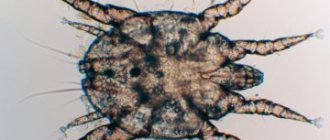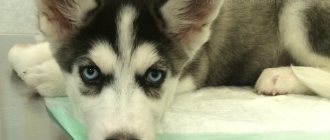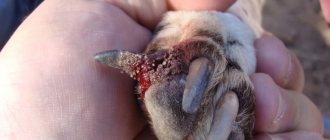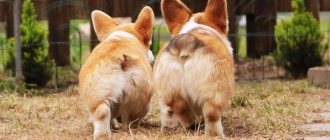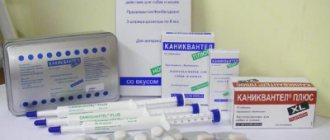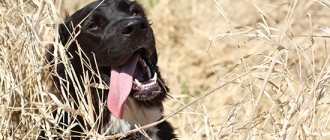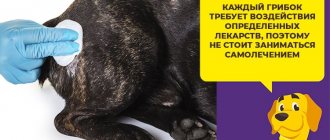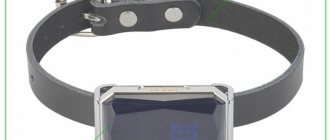Sterilization surgery is performed to stop childbearing and involves tying the fallopian tubes in females or the seminal ducts in males. At the same time, the production of sex hormones does not stop, and the animal’s behavior does not change.
When spaying male dogs, a small incision is made in the scrotum, then a surgical thread is placed on the vas deferens. In females, this operation is more complicated: in order to gain access to the fallopian tubes, the peritoneum must be opened. Often, veterinarians refer to sterilization as castration of females, when all reproductive organs are removed during the operation. But in any case, the rehabilitation process in females takes longer and is more difficult than in males.
Properly organized care for a dog that has undergone sterilization surgery alleviates its condition during the rehabilitation period and reduces the risk of complications.
The first day after surgery
Upon arrival home, it is advisable to lay the operated dog on a flat surface with bedding (preferably on the floor so that it cannot fall while moving) and cover it with a blanket. Periodically, you should moisturize the oral mucosa by dripping a few drops of water into your mouth. During recovery from anesthesia, reflex urination may occur, so you need to be prepared to replace the bedding.
The animal can come to its senses almost immediately or after a few hours - it depends on its body and the dose of anesthetic. The first sign that the dog will soon wake up will be its reaction to irritation - twitching of its paws or ears. Since motor reflexes are not restored immediately, the animal may feel weak and helpless for some time, but this does not last long.
Important! As soon as the dog is fully awake, you need to offer him water or wet his nose and tongue with water. The animal should not be fed on the first day after surgery, as vomiting may be a reaction to food.
While the dog is under anesthesia, it is advisable to ensure constant monitoring. If everything is going well, your breathing and heart rate should be rhythmic. A slight increase in temperature is acceptable, and short-term periodic muscle twitching or trembling may occur.
What is piroplasmosis in dogs
Every owner should know what piroplasmosis in dogs is! Piroplasmosis is a deadly virus, from which no pet is immune. The carriers of piroplasmosis are pasture ticks, which can attack and bite even treated dogs.
Note! Manufacturers of flea and tick preventive products do not hide the fact that ticks die on a treated dog within 12–48 hours. During this period of time, the tick will have time to bite and infect the dog if it is a carrier of the virus.
Pasture ticks can carry three dangerous diseases: piroplasmosis, Lyme disease and encephalitis. Statistically, most dogs become infected with piroplasmosis from ticks. Immediately after a tick bite, virus cells begin to multiply in the dog's blood, damaging red blood cells. Dead blood cells and viruses that are attacked by the immune system are filtered out and eliminated from the body by the liver.
Typically, the symptoms of piroplasmosis develop in the following order:
- Apathy and weakness.
- Decreased appetite.
- Increased body temperature.
- Paleness of the mucous membranes.
- Weakness in hind limbs.
- Complete refusal to eat.
- Discoloration of urine the color of dark beer.
- Decreased body temperature and classic signs of intoxication.
- Yellowness of the mucous membranes.
- Severe signs of liver failure.
- Lethargic or comatose state.
Most owners realize that their dog is infected with piroplasmosis at the stage of weakness in the hind legs or urine coloring the color of dark beer. Being under increased load, the liver suffers greatly, this creates the need for an integrated approach in treating the virus.
For piroplasmosis, special antiviral drugs are used, which are also toxic and place a serious burden on the liver. It turns out that the dog’s liver is under a triple blow: it filters out dead blood cells, the virus, and the toxic components of the antiviral drug.
Signs of danger
Dangerous signs in the postoperative period are:
- heavy uneven breathing;
- uneven or rapid heart rate;
- trembling or muscle twitching lasting more than half an hour;
- blood impurities in urine;
- suppuration of the suture;
- lack of urine for more than a day;
- significant increase in temperature.
Such symptoms may indicate the development of complications: cardiac dysfunction, pulmonary edema, or the development of a purulent infection. Detection of any of the above signs should be a reason to urgently consult a doctor.
Rehabilitation period
To prevent the development of a bacterial infection, injections of antibiotics are prescribed from the first day after surgery: Oxacillin, Amoxicillin, Ceftriaxone or Cefazolin. The standard course of antibiotic therapy is 5-7 days. If the dog is in pain, whines, avoids sudden movements, or tries to reach the scar, it is worth giving it analgesics for several days, since severe pain can slow down the healing process.
The stitches are treated with an antiseptic (chlorhexine or hydrogen peroxide) for at least a week, 2 times a day; it is strictly forbidden to wet the wound. To care for the seam you can also use:
- Levomekol ointment (apply it 1-2 times a day, covering it with a gauze cloth);
- Terramycin spray (suture treatment is carried out every 3 days);
- Aluminum spray (a product that forms a thin film that prevents contamination of the seam; it must be applied once a day).
The stitches are removed after 1.5 - 2 weeks. Most modern veterinary clinics use absorbable suture material during surgery; such sutures do not need to be removed. To prevent the dog from licking and scratching the wound, they put on an apron blanket (you need to have several of these blankets in order to change them as they become dirty). If necessary, you can purchase a special hard collar in the shape of a funnel - it will deprive the animal of the opportunity to reach the itchy seam with its teeth.
You can start feeding your pet one day after surgery. Food should be given in small portions, the food in the first few days should be soft and easily digestible: pates, minced meat, baby formula. Retention of stool for up to 3 days does not pose a danger, since the animal’s stomach was empty before sterilization, and intestinal motility after anesthesia is slow. If the dog does not recover for more than 3 days, he can be given one or two tablespoons of Vaseline oil.
Helpful information. Rehabilitation of a dog after sterilization takes about 2 weeks. In the future, it is advisable to switch her to a low-calorie diet, since sterilized animals are often prone to gaining excess weight.
Lines of ready-made food intended for castrated and sterilized animals are produced by Products Limited, Agras Delic, Purina, Bosch Tiernahrung. If you prepare food for your animal at home, it is advisable to choose lean meats and add fiber-rich vegetables to it.
You can also contact our site's staff veterinarian, who will respond to them as soon as possible in the comment box below.
Veterinarian video tips
about postoperative care:
Every owner wants his pet to be healthy and cheerful. But sometimes, to maintain health, surgery cannot be avoided. How quickly will the dog recover after surgery
, largely depends on its owner.
Of course, many of the subtleties and nuances of postoperative care depend on the breed of the animal and the type of operation.
: Agree, sterilization or castration is one thing, and spinal surgery is quite another. Your veterinarian will give you specific recommendations for care. But there are still some general rules that you need to know.
It is best if the dog spends some time in the hospital after surgery
: It is advisable that a doctor help her come out of anesthesia normally. This is especially important if the operation was complex, if the dog is young or elderly. A dog, for example, may need an IV, which is difficult to provide at home. And when the dog fully recovers from anesthesia, it will be discharged home, and there you can take care of it yourself.
A dog after surgery needs special care for an average of 10-14 days, sometimes the postoperative rehabilitation period can be 1-2 months if the intervention was serious. The first thing you need to do is create a cozy corner for your dog.
. It should be comfortable, dry and warm (but not hot). Under no circumstances should you place your dog in a draft.
To prevent the animal from licking the seams, a special blanket is put on it.
. It is better to buy 1-2 spare blankets and change them when they get dirty. Instead of blankets, an Elizabethan collar can be used. The dog must be in a blanket or collar during the entire rehabilitation period (of course, with the exception of those moments when you are treating the stitches).
Postoperative sutures are usually treated once a day with local antiseptics.
. It is recommended to use antiseptics that do not contain alcohol, for example, chlorhexidine. If in doubt, it is best to check with your veterinarian. After treatment with an antiseptic, an ointment is applied, for example, levomekol.
If the veterinarian has prescribed any medications, they must be given in strict accordance with the instructions.
. For example, antibiotic treatment may turn out to be completely ineffective if you violate the schedule or do not complete it, having independently decided that your dog is already healthy.
The dog after surgery may be restless and aggressive
. This is natural, because surgery is associated with pain and stress. Therefore, give your pet maximum care and attention. But it’s better not to let small children near her. Firstly, the dog needs peace and a minimum of physical activity, and they will bother him, trying to play. Secondly, after the operation it is difficult for her to control her aggression, so this is dangerous not only for the dog, but also for children.
By the way, about physical activity. Regardless of the type of operation, it is better to give the dog rest during the first day. The veterinarian will give further recommendations regarding physical activity. Moderate exercise in the form of short, quiet walks may even be beneficial, but excessive physical activity is harmful. It will be possible to return to normal activity only when the veterinarian informs you that the dog has fully recovered.
The postoperative diet will depend on the type of surgery and anesthesia. The veterinarian will give you precise feeding recommendations - you may be prescribed a special food, or, on the contrary, they will advise you to feed with natural food. But the general rule is that food should be light, and you need to feed in small portions, but often
. Large portions reduce appetite, and the dog after surgery already eats worse than usual. Your dog may return to a normal appetite within a few days.
The dog after surgery should have free access to clean and fresh drinking water
unless otherwise directed by your veterinarian. During surgery, animals can lose a lot of fluid; this loss must be replaced.
If you notice any alarming symptoms, you should immediately contact your veterinarian
. Such symptoms may be, for example, repeated prolonged swelling of the sutures and purulent discharge, prolonged absence of urination or defecation, low or high temperature (with the norm being 38-38.9 degrees). At the same time, it is better to play it safe and find out that everything is actually in order than to miss some important symptom.
How quickly your dog returns to normal life after surgery depends largely on you.
Your task as an owner is to strictly follow all the veterinarian’s instructions and give your pet maximum attention and care. Then your dog will quickly get back on his feet and will again delight you and your household with his company.
Dog after surgery
Normal recovery of a dog after surgery
directly depends on how carefully the owner looks after her. The veterinarian will instruct the pet owner in detail how to care for him and what he needs to know, but there are also general rules for caring for a sick animal.
How to recognize a stroke in a dog?
The success of treating signs of stroke in a dog depends on the timeliness of their recognition and the timely initiation of treatment for the pathological condition. Any animal owner who is attentive to their pet can suspect the first manifestations of the disease. Dogs with stroke exhibit behavioral changes. Animals may behave restlessly, show aggression, or, conversely, sleep a lot and refuse food. Sometimes pets have hearing impairments, they do not respond to commands, do not respond to their name, but simply wander around the room, periodically resting their heads on the floor or wall. Naturally, such changes in the dog’s behavior cannot be ignored and the animal must be immediately taken to a veterinary clinic.
Stroke in a dog, the symptoms and treatment of which depend on the type of pathological process, at the stage of developed clinical signs is manifested by loss of motor activity in one or several limbs at once, asymmetry of the facial muscles, when one eyelid or lip noticeably droops, curvature of the body, disorders of the pupils ( nystagmus, mydriasis, etc.).
In severe cases, the symptoms of a stroke in a dog are more pronounced:
- paralysis of one half of the body;
- epileptic seizures;
- loss of consciousness;
- disturbances in the functioning of internal organs (heart rhythm failure, respiratory arrest);
- deep coma.
Unfortunately, signs of cerebral circulation disorders in an animal are not always noticeable to its owner. Thus, a micro-stroke in a dog, the symptoms and treatment of which pose a certain diagnostic and therapeutic difficulty even for experienced veterinarians, can be asymptomatic or in the presence of mild changes in the pet’s behavior, apathy, loss of appetite, interest in games and others.
Postoperative nutrition for the animal
The dog breeder wonders why
Should
I feed my dog after surgery
? We offer the following:
- Feeding should be done little by little so as not to burden the body, since a lot of energy is spent on digesting food.
- After surgery, the dog does not eat or drink for several hours. This is especially true for operations performed on the peritoneum.
- There is no need to worry that the dog does not go to the toilet after surgery
. This is natural, because she doesn’t eat anything. And to avoid constipation, you need to stick to a diet. It is better to give dietary food, which is sold in special canned food. Hard food softens in warm water. This type of diet is observed for about 30 days. It is better to return to your normal eating rhythm gradually. To do this, the usual food is gradually mixed into the diet. - In the postoperative period, it is preferable to give the dog broth, cottage cheese, kefir and porridge.
- There must be fresh drinking water near the dog.
- The owner must inform the treating veterinarian about negative reactions to food in the form of vomiting, diarrhea, constipation.
What is the feature of the protective structure?
A collar for a dog after surgery serves as a kind of limiter or barrier in protective therapy. The technique helps protect the dog from causing various types of damage to itself and prevents it from biting or scratching itself. This increases the likelihood of the wound healing quickly. These devices are prescribed by veterinarians in case of surgery, as well as in other incidents.
Pets do not like to visit clinics, so restraints in the form of collars make it possible to visit doctors less often. The wound heals faster, the risk of infection is reduced, and the dog does not come into contact with drugs used to treat the skin.
The device has the shape of a cone, which is cut off at the top. The material can be anything that holds its shape. The positive thing is that an animal with such a device eats food calmly. Try to get the dog used to this thing, and then it will stop worrying and accept it better.
What complications can occur after surgery?
A dog after surgery needs quality care
because she is more susceptible to complications that may arise against this background. Among other things, you cannot always force the dog to rest in order to allow the wound to heal normally. This is due to the fact that you cannot explain to her how to behave after the operation, namely:
- If the dog is not stopped in time, it can damage the wound and this will lead to the resorption of the sutures.
- Allergies can also occur in dogs. The owner does not always know the reaction of the dog’s body to one or another type of drug.
- Swelling after surgery in a dog
may occur due to excess fluid that has accumulated near the wound. Swelling will cause the stitches to come apart and the wound will be vulnerable to infection. - Bloody discharge from a wound in the first days after surgery should be a cause for concern.
- If the sutures dissolve early or are placed incorrectly, a hernia may form.
In cases of intestinal blockage and other serious conditions in dogs, a successful operation is only half the success. And the second half of success is care after surgery. And it depends on what kind of post-operative care you provide to your dog whether it will live.
Postoperative care in dogs
includes: - antibacterial therapy (antibiotics); - intravenous drip administration of solutions (droppers). Saline solutions, glucose, and, if necessary, amino acid solutions for parenteral nutrition; — detoxification (sorbents), — cardiac medications, as well as, if necessary, medications for various organs (liver, kidneys, pancreas, etc.)
More information about post-operative care in dogs:
1) Antibiotics
. After any surgical intervention on the abdominal cavity (including after pyometra, removal of a foreign body from the intestine, and, of course, with peritonitis), antibiotics are required. Ceftriaxone is quite suitable at the rate of 1 gram per 42 kg of weight daily dose or 25-30 thousand per kilogram of weight (also a daily dose). The daily dose can be administered intramuscularly once a day, or can be divided into 2 times. Dilute with 0.5% novocaine. Your doctor may prescribe a higher dosage of ceftriaxone. The duration of the antibiotic course depends on the type of surgery. If it was a planned sterilization, 5 days will be enough (if everything is fine, the temperature is normal, the dog is eating). If the dog has been operated on for pyometra, or an enterotomy has been performed (surgery on the intestines), and even more so if peritonitis has begun, an antibiotic is administered for 7-10 days. If necessary - 14 days. If necessary, you can continue the course of one antibiotic for 3 weeks. But, in my opinion, if there is no positive dynamics within 10-14 days after the operation, you need to either change the antibiotic or, in addition to ceftriaxone (or another antibiotic that you use), prescribe IV Metrogyl for antibacterial therapy. Dose: for example, for a dog weighing 30 kg, we administer 50 ml of Metrogyl intravenously once a day. If your dog has peritonitis, you do not need to wait 10-14 days after surgery. Prescribe Metrogyl, it gives good results in the treatment of peritonitis.
2) Intravenous drip administration of solutions
. After scheduled sterilization of a healthy dog, this item is not necessary.
If the dog has not eaten for several days before the operation, and will not eat for several more days after the operation (for example, during intestinal surgery), drip administration of solutions is a mandatory procedure after the operation. And to relieve intoxication, and to normalize the volume of fluid in the body, and to normalize the salt composition of the blood.
Dosage: 20-30 ml of liquid per kg of dog weight is the daily dose.
5% glucose solution (if the dog does not have diabetes). Saline solution, Ringer's solution, Ringer-Locke solution. After the operation, the dog does not eat for the first day, this is normal. He may not eat for 2 or 3 days. In particular, after surgery on the intestines, the dog is not fed for three days. If the dog is not exhausted, it is quite possible to live for 3 days on solutions, without additional nutrition. If the dog was exhausted before the operation, or if the period without food is prolonged. There are, after all, severe cases when the dog does not eat for up to a week, and sometimes longer (with high levels of creatinine, urea, amylase, other reasons for refusal of food are possible). In this case, amino acid solutions for parenteral nutrition should be added to the aqueous solutions.
3) Add to the dropper
ascorbic acid, sulfocamphocaine, thiotriazoline (or riboxin).
a biochemical blood test immediately after the operation
. Biochemistry will show which organs need special attention and what other drugs are needed for treatment. If it was not immediately possible to do a biochemical blood test, you can start using the standard regimen. If after 3 days the dog has not started eating, then we still do blood biochemistry to understand what and how to treat. If it is not possible to do blood tests, we turn on logic. After all, once upon a time dogs were not given blood biochemistry and were treated somehow. Let's play it safe. We take Essentiale intravenously (or Gepar compositum) for the liver, and Solidago compositum for the kidneys. As a budget option, you can take thiotriazoline: it is good for both the liver and the heart. Contrical for the pancreas.
5) Traumeel
.
After planned sterilization, it is quite possible to do without traumeel. In more severe cases traumeel is VERY good
as a means of
relieving inflammation and accelerating regeneration (healing)
.
We start with intravenous administration, then switch to intramuscular. If the situation is severe, the inflammation is significant, the first 2-3 days are injected every day. Then we switch to injections every other day, then 2 times a week. If the situation is initially not bad, we start every other day, then 2 times a week. If the operation was planned, the animal feels well, a day after the operation it begins to eat, and you can easily do without tarumel. But in this article we are talking about the postoperative period
precisely after severe conditions: pyometra, peritonitis, enterotomy (intestinal dissection).
6) If after intestinal surgery
vomiting
does not go away , it is not always possible to use cerucal, so as not to provoke too active intestinal contractions. And, by the way, cerucal does not always help. The injection drug Rantak (ranitidine) can be very helpful.
If the dog has already experienced peritonitis, a very important point is proper sanitation of the abdominal cavity.
And, of course, special attention to the processing of seams.
A dog's recovery after surgery largely depends on the care it receives, whether it be neutering or spinal surgery. Of course, in each specific case, the veterinarian will tell you in detail how to care for your pet, but there are also general rules that a dog owner should know. Dogs need special
on average within
10-14 days
, although with serious intervention the period of postoperative
rehabilitation can extend to 1-2 months.
Why does a dog have a stroke?
The factors contributing to the development of cerebral stroke in a dog differ from the causes of a similar pathological condition in humans. In animals, the narrowing of the lumen of blood vessels does not occur as a result of the adhesion of harmful cholesterol to the intima, but due to the thinning of their walls under the influence of toxins, medications, inflammatory processes in the blood, metabolic diseases, visceral organs, and the like. Signs of a stroke in a dog develop due to blockage of the blood vessels of the brain by tumor particles, blood clots, bone fragments, pieces of fatty tissue or parasites.
Among the causes of stroke in dogs are the following:
- head injuries;
- stress and nervous tension;
- poor quality feeding of the animal;
- natural aging processes of the dog’s body;
- chronic pathological processes;
- intoxication of various origins;
- helminthic infestations;
- diabetes;
- obesity;
- sedentary lifestyle.
What to feed your dog after surgery
- An important general rule is that you need to feed your dog often, but in very small portions. She still has no appetite, and her body needs energy to recover, and there is no need to distract it by digesting food.
- Immediately after surgery, the dog should not be fed or watered for several hours. This is especially important if the operation was performed in the abdominal cavity.
- Also, food should be light and preferably liquid. It is better to soften it in warm water or give it special canned food from a diet line. It is better to keep the dog on this line for a month. It is better to return to a normal diet gradually, mixing the usual food with the medicinal food over the course of a week.
- With natural feeding, broth is given once, at the first postoperative meal, and then semi-liquid porridge with minced meat, cottage cheese, and kefir. Unless, of course, the veterinarian gave other recommendations.
- The dog must have free access to fresh drinking water.
Photo: Caring for a dog after surgery
How to boost your dog's immunity after illness
Millions of protozoa, bacteria, viruses, fungi, parasites and other enemies of health attack the body of pets every second. Strong immunity in dogs, just like in people, is on guard around the clock - protective cells destroy foreign microorganisms before they can cause harm. But what to do if the health guards are tired? How to strengthen your pet's immunity in a safe way?
Immunity can be innate (or natural) and acquired (or artificial). If a dog has suffered a viral infection and has developed immunity to this virus, they speak of acquired immunity. Viruses are very insidious and dangerous: some can kill, others cause irreparable harm to health. Fortunately, today it is not difficult to fight viruses; you just need to regularly vaccinate your dog. This is the only available way to increase artificial immunity. A vaccinated dog has increased resistance to the diseases for which it is vaccinated - enough not to be afraid of viral infections.
But with innate immunity, everything is more complicated. It is influenced by a lot of factors - lack of vitamins, poor nutrition and living conditions, heredity, emotional state, chronic illnesses, past traumas, ecology and much more.
Parasites have a negative impact on resistance:
worms very quickly undermine the immune system, releasing toxins and literally poisoning the pet from the inside;
fleas and other bloodsuckers damage the integrity of the skin, which, coupled with scratching, leads to bacterial infections;
After a mite lives on the skin (scabies, otodectosis) or under the skin (demodectosis), even a vaccinated dog can become susceptible to viruses, since these parasites kill the immune system. An allergy is possible to any parasite - a “failure” of the immune system, accompanied by chronic symptoms. Allergy, being an immune disease, itself further undermines the immune system.
Often, increasing immunity in dogs is necessary after suffering an illness, surgery, stress, exhaustion, or taking medications (antibiotics or toxic drugs).
There are several methods for boosting immunity, but they only work in combination. Therefore, there is no choice - we need to act on all fronts.
1. Prevention, getting rid of parasites. This is the lifelong responsibility of every dog owner. Drops on the withers against blood-sucking reptiles once a month, a tablet against helminths once every 4-6 months. Choose quality products (cheap insecticides are toxic).
